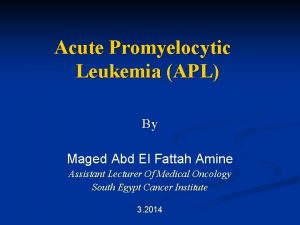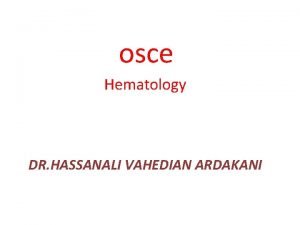Acute Myelomonocytic Leukemia and Its Clinical Presentation A

- Slides: 1

Acute Myelomonocytic Leukemia and Its Clinical Presentation: A Case Study Megan Kilpatrick, Morgan Schmitmeyer, Kati Woodward, Erin Rumpke MS, MLS , College of Allied Health Sciences, Department of Medical Laboratory Science BACKGROUND Acute myelogenous leukemia is a clonal disorder in which myeloblasts and monoblasts dominate in the bone marrow, uncontrollably displacing the normal cells. Acute leukemias are categorized differently by the French American British (FAB) and the World Health Organization (WHO). Acute myelomonocytic leukemia (AMML) is a type of acute myelocytic leukemia (AML) classified as M 4, which is defined as greater than thirty percent blasts for the WHO and greater than twenty percent blasts for the FAB. In AMML cases, chromosomal abnormalities and gene fusions commonly cause immature cells to overproliferate in the marrow. In acute myelogenous leukemias, the immature precursors cells are differentiated by flow cytometry, cytogenetics, immunophenotyping, and special stains. DISCUSSION ABSTRACT A 67 -year-old female presented for an antiogram with an abnormal complete blood count (CBC). White blood cell (WBC) differential showed 17% blasts which initiated performing a bone marrow biopsy. The bone marrow aspirate smear showed an increased number of blasts and the bone marrow core biopsy showed 90% cellularity where normal precursors were replaced by blasts. Flow cytometry and chromosome analysis results were consistent with Acute Myelomonocytic Leukemia (AMML). FLAG chemotherapy was initiated until a goal of 0. 91. 0 x 10^9/L absolute neutrophil count is achieved, at which time a catheter will be placed to address cardiac comorbidities. Cardiac disease and AML comorbidities are commonly encountered in oncology patients. Treatment plans must account for possible cardiac complications. The complex history of cardiac disease and present cardiac issues complicate this case. AMML is one of the most difficult leukemias to treat. Management is increasingly more difficult when AMML is comorbid with other conditions, such as cardiac disease. Precautions must be taken as cases where common AML treatments have caused cardiomyopathy and heart disease have been documented. This patient must be treated with great care to ensure the chemotherapy does not worsen her cardiac symptoms. Chemotherapy for AML often includes anthracycline based treatment that can have high mortality and morbidity in patients of advanced age or with comorbidities. Patients with pre-existing cardiac disease or previous exposure to anthracycline are at risk of developing cardiotoxicity, defined as muscle damage or an electrical dysfunction of the heart (Saini et. al. , 2014). Anthracyclines have been correlated with higher rate of congestive heart failure (Anderlini et. al. 1). This patient who has a history of a bundle branch block and an ICD regulating her heart’s rhythm would be put in danger by treatment via anthracycline due to the cardiac electrical dysfunction that could result. The oncologist treating this patient chose to treat her AMML with FLAG chemotherapy. FLAG is a common chemotherapy regimen used to treat newly diagnosed acute myeloid leukemias in patients that are older, have pre-existing heart disease, or have other significant comorbid diseases. FLAG is comprised of fludarabine, cytarabine, and granulocyte stimulating factor (G-CSF). Fludarabine increases the production of cytarabine metabolite in AML cells, the cytarabine is an antimetabolite against the AML cells that are now producing increased amounts of the cytarabine metabolite, and the G-CSF stimulates the production of more white blood cells to compensate for neutropenia (Pastore, et. al. , 2003). CASE PRESENTATION A 67 year old female scheduled for angiogram due to an abnormal stress test presented with an abnormal complete blood count (CBC) including low hemoglobin, low platelets, high white blood cell (WBC) count, and a WBC differential with 17% blasts. Further testing provided a diagnosis of Acute Myelomonocytic Leukemia. Peripheral blood smear analysis showed 17% blasts with fine chromatin and multiple nucleoli, and the presence of nucleated red blood cells. Both myeloid and erythroid populations in bone marrow aspirate were increased, noting 47% medium sized blasts and 39% erythroid precursors as a relative proportion of all nucleated cells. The myeloid precursor cells show a left shift and dysplastic cytoplasmic granulation. Bbone marrow core biopsy showed 90% cellularity and was largely replaced by aggregates of medium sized blasts with prominent nuclei. Very few megakaryocytes were seen in the marrow, explaining the patient’s low platelet counts. The clot section and biopsy of the bone marrow was stained with various immunostains to identify the type of blasts present. The blasts were positive for myeloperoxidase and a small proportion were positive for CD 34 and CD 117, confirming myeloid origin. The iron stain showed no ringed sideroblasts and the PAS stain showed few megakaryocytes. Chromosome analysis showed an trisomy 8. This karyotype mutation is the most frequently seen in patients with myelodysplastic syndrome (MDS) and acute myeloid leukemia (AML). Fluorescence in situ hybridization (FISH) analysis confirmed the presence of trisomy 8 with a signal pattern of 3 A. Trisomy 8 mutation is associated with an intermediate prognosis for patients, better than -7/7 q- and worse than -5/5 q- (Schaich, M. , Et. al. , 2007). Flow cytometry identified two populations of blasts present; CD 34 positive myeloblasts and CD 34 negative immature cells of myeloid lineage with monocytic differentiation. This indicates acute myelomonocytic leukemia. 10% of cells are myeloid blasts positive for CD 13, CD 34, CD 38, CD 71, CD 117, HLA-DR, and myeloperoxidase. 39% of blasts are immature myeloid cells with monocytic differentiation positive for CD 64, CD 33, CD 15, CD 4, CD 38, CD 71, HLA-DR, and myeloperoxidase but they are negative for CD 34 and CD 117. Figure 1: Peripheral blood smear showing blasts of myelogenous origin, some with monocytic differentiation. TREATMENT & OUTCOME In California, a study conducted with AML patient raises additional concerns. This study demonstrated an increased risk of developing deep vein thrombosis (DVT) in patients with acute leukemia, especially in the beginning stages of treatment. Identified risk factors include being female, having a central venous catheter, and having two or more chronic comorbid conditions (Ku, et. al. 2008). This could be significant for the patient in this case study as she is newly diagnosed with AML, is in the beginning of her chemotherapy treatment, and has the additional risk factor of being female. Oncology planned to proceed with FLAG induction chemotherapy, a typical AML treatment regimen. A few days post diagnosis the patient presented to the emergency room with severe chest pain, profuse sweating and lip numbness. She was admitted for observation. Patient history reports cardiomyopathy with a Bundle Branch Block (BBB) and placement of an Implantable Cardioverter Defibrillator (ICD) to regulate the heart’s electrical activity, but no history of myocardial infarction. Additional history shows hypertension, fibromyalgia, osteoarthritis, melanoma, asthma, and a hiatal hernia for which she did not have surgery. CBC A performed the day the of patient’s visit the to ER, there were abnormal results of: high WBC, low RBC, low hemoglobin, low hematocrit, low MCHC, high RDW, very low platelets, low neutrophils, high lymphocytes, high eosinophils, high atypical lymphs, high nucleated RBCs, 48% blasts, anisocytosis, polychromasia, and high reticulocyte count. Quantitative D-dimer performed at the same visit was increased and a comprehensive metabolic panel showed an abnormally high AST level. Consultation to review FLAG chemotherapy and the possible side effects cautioned of low blood counts, increased infection risk, hair loss, a anemia, and the possibility of hospitalization. FLAG induction treatment began the following week and will be continued until her absolute neutrophil count lowers to 0. 9 -1. 0 x 10^9/L and shows no signs of leukemia. Cardiology plans to proceed with heart catheterization post recovery from treatment. CONCLUSION . Acute myeloid leukemia alone has a dismal rate of recovery, with only 26. 8% of patients surviving more than 5 years after diagnosis (National Cancer Institute, 2012). Comorbidities with conditions like cardiac disease complicate treatment and are likely to make the patient’s chance of survival even lower. More research is needed to determine the possible links between AML and cardiac disease in order to better care for patients like the one in this case study. Despite the high morbidity and mortality rates new treatments for AML are continually being developed, especially treatments for patients with preexisting health conditions since treating these patients is most difficult REFERENCES Anderlini, P. , Wong, F. C. , Katarjian, H. M. , Benjamin, R. S. , Andreef, M. , Kornblau, S. M. , Estey, E. (1995). Idarubicin cardiotoxicity: a retrospective study in acute myeloid leukemia and myelodysplasia. Journal of Clinical Oncology , 13(11), 2827 -2834. Ku, G. H. , White, R. H. , Chew, H. K. , Harvey, D. J. , Zhou, H. , & Wun, T. (2008). Venous thromboembolism in patients with acute leukemia: incidence, risk factors, and effect on survival. Blood Journal, 113(17), 3911 -3917. Pastore, D. et. al. (2003) FLAG-IDA in the treatment of refractory/relapsed acute myeloid leukemia: single-center experience. Schaich, M. , Et. al. (2007). Prognosis Of Acute Myeloid Leukemia Patients Up To 60 Years Of Age Exhibiting Trisomy 8 Within A Non-Complex Karyotype: Individual Patient Data-Based Meta-Analysis Of The German Acute Myeloid Leukemia Intergroup. Hematologica, (92), 763 -770.

